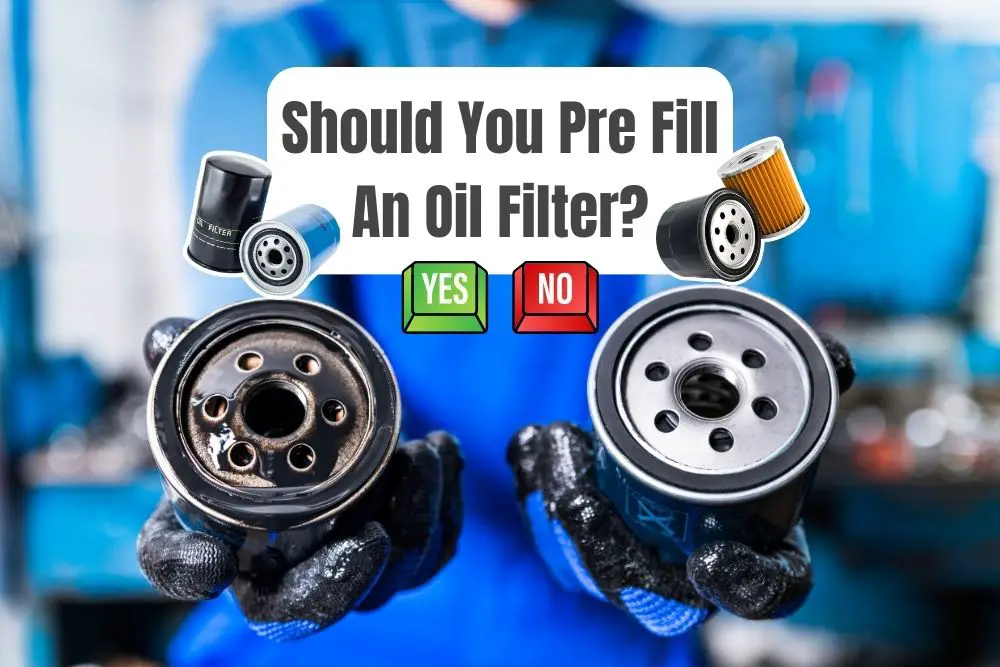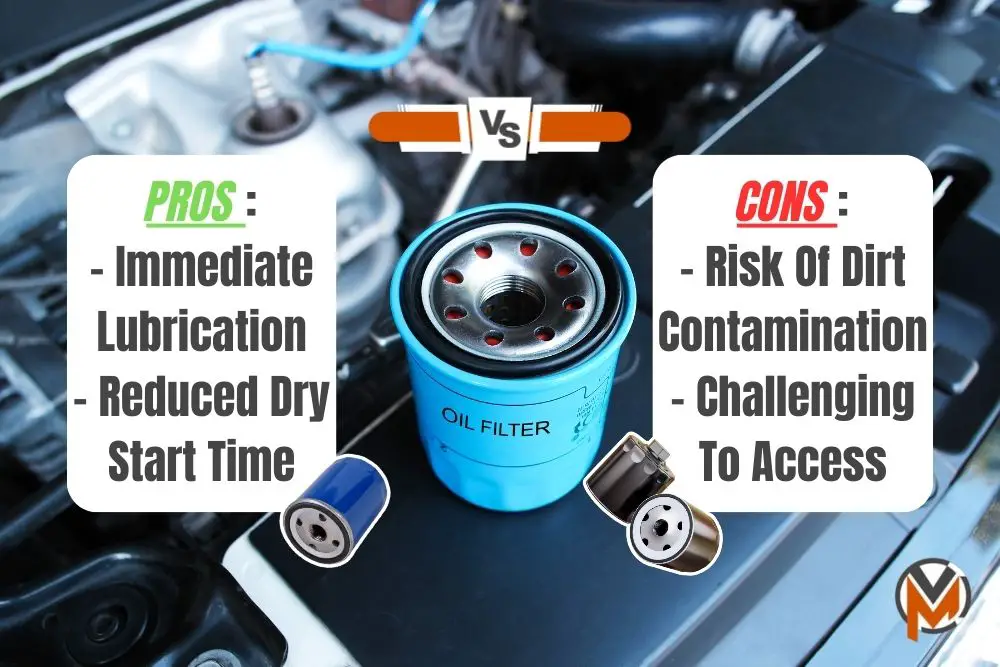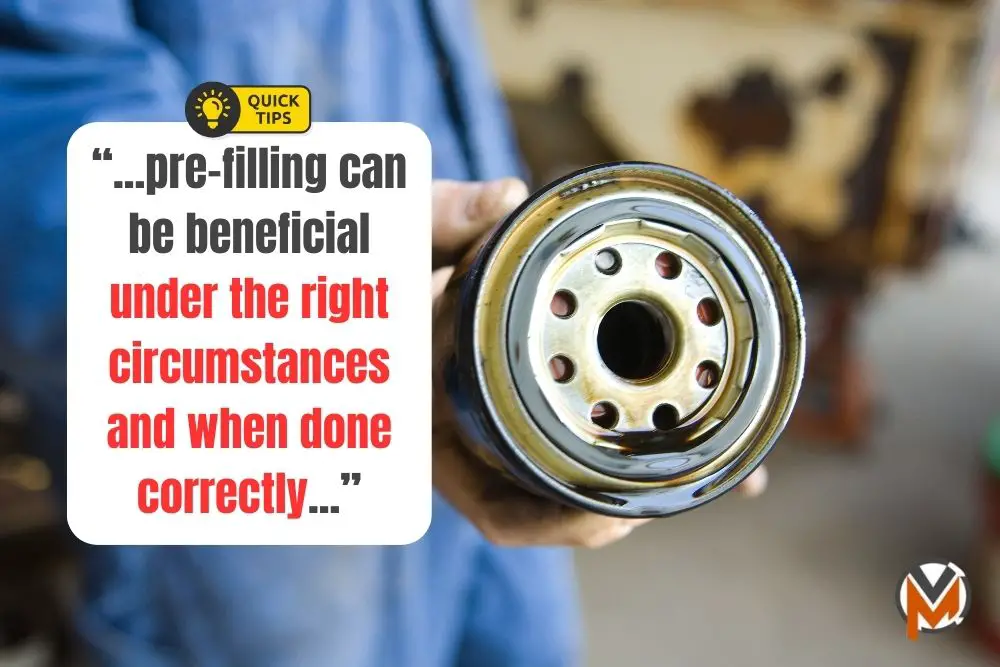One of the most divisive, and oft-misinformed and confused subjects relating to oil changes is whether or not you should pre fill an oil filter when replacing it. Is it even safe (or not!) for your engine to do this?
Well, as expected, there’s no singular, definitive answer to this, and whether or not you should pre fill the oil filter during an oil change or oil filter replacement varies from one car and scenario to another one.
You’ll need to consider factors such as what sort of vehicle or engine you have… For example, older diesel engines and classic cars, as well as high-mileage cars can sometimes benefit from pre-filling the filter.
Otherwise, there are also some risks attached to pre-filling the oil filter, such as potentially introducing contaminants into the filter. Moreover, in some cars, accessibility might be challenging to pre fill it.
- Do you need to pre-fill the oil filter?
- Pros & cons of pre-filling the filter
- How to pre-fill the oil filter properly?
- Should you really pre-fill the oil filter?
Fill Oil Filter Before Installing
As I mentioned earlier, the topic of pre-filling your oil filter is a divisive and contentious topic, and one that has sparked debate amongst enthusiasts, DIYers, mechanics, and professionals on which one is right.
Remember that your engine’s oil filter is responsible for removing contaminants from engine oil, which can accumulate over time and cause damage to your engine, impacting its smooth operation and longevity.
When it comes to the need to doing this, there are 2 general arguments FOR and AGAINST it (we’ve created a quick cheat sheet further down below on whether or not you should consider doing this):
- Some folks argue that pre-filling the oil filter ensures immediate oil pressure and lubrication upon starting the engine, which is particularly important in older or high-mileage vehicles.
- On the other hand, others suggest that modern engines are designed to cope with the brief moment of low oil pressure at start-up, making pre-filling the oil filter beforehand unnecessary.
Pre Fill Oil Filter Or Not
So, to try and settle this debate once and for all, here are the general pros and cons of doing this:
Pros
1) IMMEDIATE LUBRICATION:
Pre-filling your oil filter ensures that motor oil is readily available to your car’s engine upon start-up. This is why many continue to advocate this as a genuine technique.
This is particularly beneficial for older engines or those vehicles with pretty high mileage, where its internal components may be more susceptible to wear and tear.
Immediate lubrication can significantly reduce the friction between moving parts, offering a smoother start and potentially extending the engine’s lifespan and longevity.
2) REDUCED DRY START:
A dry start occurs when your engine operates without adequate lubrication for a brief period. This situation can lead to increased wear and tear on the engine, and it’s a pretty bad idea.
By pre-filling your oil filter, you minimize the time your engine runs without oil after an oil change, thereby reducing the risk of damage caused by insufficient lubrication during these first moments of operation.
Cons
1) POTENTIAL CONTAMINATION:
The process of pre-filling the oil filter carries the added risk of introducing contaminants. This can happen if the oil or funnel used is not clean, or if the environment where it’s taking place is dusty or dirty.
During said oil change, contaminants can clog the filter or damage the engine. It’s crucial to use clean tools and engine oil, and perform the task in a clean environment to mitigate this risk of contamination.
2) PRACTICAL ACCESSIBILITY:
Depending on your car’s make and model, the engine oil filter’s position might make pre-filling challenging or messy. In some cases, the oil filter is mounted in a way that pre-filling could cause spillage.
During the installation process, this can lead to a messy work area and potential waste of oil. This is more common in vehicles where the filter is attached horizontally or if it’s placed in a hard-to-reach area.
How To Pre Fill An Oil Filter
So, for those vehicles or scenarios that could benefit from doing this, here’s how you do it safely and properly:
- STEP 1 – Prepare a Clean Workspace:
- Ensure that the area where you’re working in is free from dust, dirt, and debris. Cleanliness here with your workspace is key to preventing contaminants from entering the oil filter and engine.
- STEP 2 – Gather the Necessary Tools:
- Make sure you have a clean funnel and fresh motor oil at hand. Also, ensure that the funnel is free from old oil residue or dirt. This is vital to preventing contamination, as I’ve warned earlier.
- STEP 3 – Slow and Steady Filling:
- Gradually pour oil into the filter. This allows the filter media to absorb the oil without air pockets forming. Bear in mind, that rushing this process can lead to incomplete saturation of the filter media.
- STEP 4 – Check for Proper Level:
- Avoid overfilling the oil filter. Therefore, fill it to just below the top to prevent any spillage when installing. Some filters may have a ‘fill line’ indicator.
- STEP 5 – Careful Installation:
- Once filled, carefully screw the oil filter back onto the engine. Ensure it’s secure but avoid overtightening, which can damage the filter or create a seal that’s too tight.
Do You Fill The Oil Filter With Oil
After analyzing numerous perspectives and expert opinions, it’s clear that the decision to pre-fill an oil filter is not a one-size-fits-all solution. Here’s my definitive cheat sheet on whether should you do it or not:
- Recommended for Older or High-Mileage Vehicles – These engines can benefit significantly from immediate lubrication, reducing wear and tear during start-up.
- Consider Vehicle and Filter Design – In a car where the oil filter is easily accessible and can be filled without spillage, doing this can be a practical choice.
- Weigh the Risks – If you’re working in a less-than-ideal environment or are unsure about keeping your oil contaminant-free, it might be safer to skip pre-filling.
- Personal Preference Plays a Role – Ultimately, if you’re comfortable with the process and understand the benefits and risks, pre-filling can be a part of your regular maintenance routine.
In conclusion, pre-filling your car’s oil filter can be beneficial under the right circumstances and when done correctly. However, it’s not an absolute necessity for all vehicles, nor is it always recommended.
Furthermore, this decision should be based on specific factors like vehicle age, engine type, and the practicality of the process for your particular vehicle. So, I hope that helps you figure out whether or not you need to even do this.



